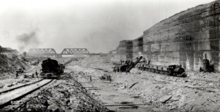The Welland Canal Riot occurred in Ontario, Canada. Armed conflict among Irish workers made the Second Welland Canal construction a riot area from 1842 to 1844. The laborers were continuously attacking and counterattacking. The police force became involved to protect and arrest.[1]

Background
editThe Welland Canal was first completed in 1829 and is located in Ontario, Canada. It enabled ships to travel the waterways which connect Lake Ontario and Lake Erie. The construction of the Second Welland Canal was from 1841 to 1845.[2] Several riots during construction of the Second Welland Canal were instigated by the Irish workers.[1]
Causes
editIn 1841, with the start of the construction for the Second Welland Canal, a labor surplus began in Canada with large numbers of southern Irish immigrants. The unemployed Irish immigrants left their home starving and preferred the labor of the public works along the Welland Canal.[1] There was an abundance of these unruly laborers not adopting the Canadian standards. Their common ethnicity allowed them to collude together with united protests. The primary conflict along the canal was class riots among the Irishmen.[1] There was conflict with wages, unemployment, and food shortage. The changes in the economy were so drastic for workers that they needed high wages due to the reduction of work. Work was limited and inconsistent, especially in the wintertime because of the conditions. The pay was so low that they struggled to afford the necessities for their families. They decided they would sit outside of the canal until they got work. Most of the immigrants proclaimed to be laying on the fronts didn't even have the resources to survive, nor could they go anywhere else for employment.[1]
Events
editThe Irish workers started to riot with each other. Two factions, men of Cork County and Connaught County, were feuding with each other. Hostility between the two factions grew as they were trying to obtain work between each other. They would combine efforts to ensure their workers had jobs by “patrolling” the canal and “driving off any who tried to take a job”.[1] However, each faction would then turn to violence while ensuring employment for their individual group. The fighting was constant and was “part of the way in which canallers organized their lives, membership in a faction dictating both working and living arrangements”.[1]
Riots
editFrom December 1842 through January 1843 in Broad Creek, Ontario, Welland Canal faction rioting occurred between the Corkmen and Connaughtmen. They were armed with pitch forks, pistols, guns, and swords fighting each other in the streets. For this revenge on the Corkmen, the Connaughtmen stole the weapons from blacksmith shops along the canal.[1] For the Welland Canal faction riot December 1843 in Allanburg, Ontario, the Corkmen and Connaughtmen were clashing while drinking and “accosted” bystanders. The Corkmen were avenging their loss against the Connaughtmen by rioting.[3] In December 1843 at Thorold, Ontario, Welland Canal rioting hastened while the two factions were beating each other with pikes or poles and innocent canallers were attacked. The police force got involved to protect and arrest offenders.[3]
Outcomes
editThe Board of Works condemned rioters for dismantling construction schedules and costs. Rioters would be banned from public works projects and spent time in jail as the Board attempted to stop disturbances. The Board of Works passed the “1845 Act for the Preservation of the Peace near Public Works, the first in a long series of regulatory acts directed solely at controlling canal and railway workers throughout the nineteenth century”.[1] This act was for the prevention of riots and violence at and near Public Works under construction. Also, rioters could not have any type of weapon in their possession. The act also allowed police forces to be on site. With the act in place, the Board helped during riots because of their responsibility to help contractors meet deadlines by providing protection for the workers willing to work.
References
edit- ^ a b c d e f g h i Bleasdale, Ruth (1981). "Class Conflict on the Canals of Upper Canada in 1840s". Labour / Le Travail. 7 (Spring 1981): 9–39 – via JSTOR.
- ^ Jackson, John (1997). The Welland Canals and Their Communities: Engineering, Industrial, and Urban Transformation (1 ed.). University of Toronto Press. p. 5. ISBN 9781442682542.
- ^ a b Way, Peter (1993). Common Labour: Workers and the Digging Of North American Canals 1780-1860. New York: Cambridge University Press. ISBN 0-521-44033-5.